This time around I would like to talk about a camera that has been my gateway into photography again. Introduced in April 1981, a 35mm SLR that packed all the tech available at the time, and then some. It’s predecessor, the Canon AE-1. Of course you read it on the title, I am talking about the Canon AE-1 Program.
Developed for auto exposure. A feature also available on the Canon A-1 but considered a higher end camera. The AE-1 Program was able to revolutionize the photography industry at the time. Specially for the average enthusiast. Making high quality cameras and features available to the average Joe. Like me.
Before we dig deeper, it is worth mention that product design back then, took as much if not longer than today. Take this camera as an example, It’s design started in 1974 and it took 28 months to complete. Now let us dig deeper into this camera.
Key Innovations
The Canon AE-1 Program came to the world of photography to democratize and revolutionize. This camera added Microprocessor integration. Not the first one to do it, but the first one to do it at this level. It was a collaboration with Texas Instruments (TI), a leader in many industries but not on Microprocessors. From the SLRs using computer technology, the AE-1 Program was one of the pioneers.
Besides the fact of adding more computer bits, the AE-1 Program brought a simplified design. And when I say simplified design, I mean that it eliminated about 300 parts (20 – 25%) from the Bill Of Materials (BOM). Let’s make it clear, mechanical parts that were replaced by electronics.
Out of the multiple exposure modes included on the AE-1 Program, the big highlight was Auto Exposure, basically letting you play with the trigger and leaving the rest to the camera. Pretty much making it a point and shoot, letting the camera make all the decisions but when to take the shot. The other two modes were Shutter Priority, and Manual.
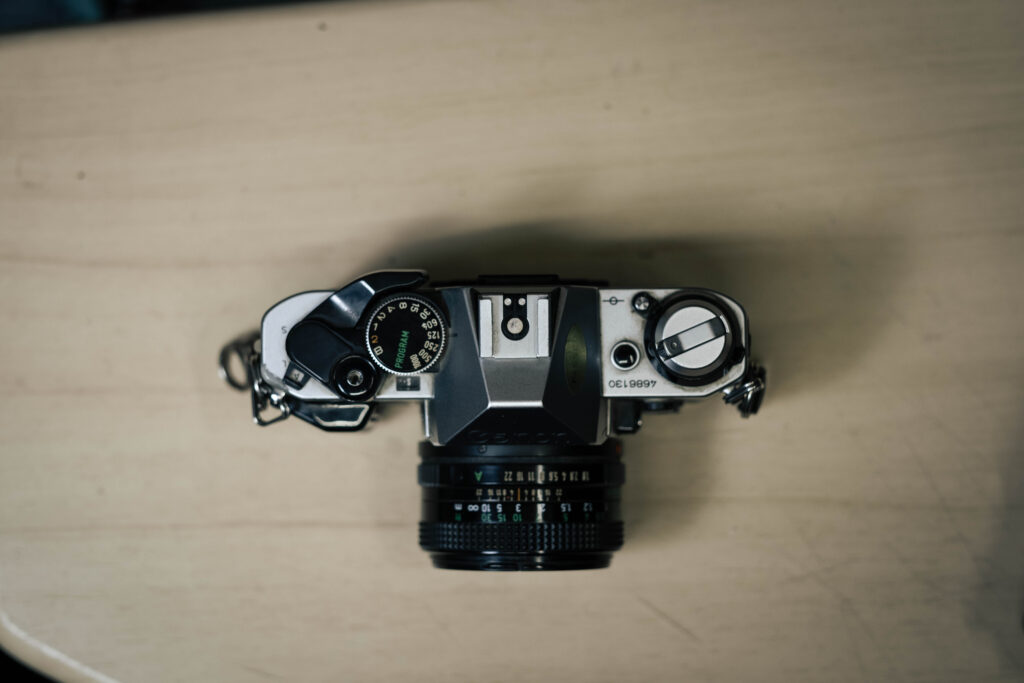
Feats and Specs
Let’s get the details out of the way and look into the AE-1 Program spec sheet.
Lens mount: Canon FD.
Shutter: Cloth – Curtain focal-plane shutter. With speeds of 2 to 1/1000 of a second.
Penta prism view finder.
Metering: TTL full-aperture center-weighted averaging metering.
Film speed range: ISO 12 to 3200.
Dimensions: 141 x 88 x 48 mm.
Weight: 565g (slightly lighter than its predecessor)
Main differences between the AE-1 and the AE-1 Program
But what was different from the predecessor? If the AE-1 had some computerized capabilities, why the AE-1 Program created such a stir in the industry. Well, let’s look into the main differences between the two.
- Exposure Modes: The AE-1 Program added a Program mode, allowing the camera to automatically select both shutter speed and aperture. The original AE-1 only offered shutter priority and manual modes.
- Viewfinder: The AE-1 Program featured a larger and brighter viewfinder. The best ever installed on a manual focus Canon camera, essentially the same as the one used on the professional-grade F-1.
- Focusing Screens: The AE-1 Program supported eight interchangeable focusing screens that could be replaced by the user. The original AE-1 did not have this feature.
- ISO/ASA Selector: The AE-1 Program improved the ISO selector, making it much easier to use compared to the finicky and prone-to-breaking selector on the original AE-1.
- Design: The AE-1 Program simplified some elements like the nameplate, which was stamped directly into the pentaprism rather than being a separate protruding plate.
- Weight: The AE-1 Program was slightly lighter at 565 grams compared to the AE-1’s 590 grams.
- Viewfinder Display: The AE-1 Program used LED lights in the viewfinder to display settings, while the AE-1 used a needle display.
- Accessories: The AE-1 Program was blessed with a removable grip and a motor drive (sold separately), not available for the AE-1
Both cameras shared the same core construction, dimensions, and many other features, including the use of the FD lens mount and a maximum shutter speed of 1/1000th of a second
Main Camera Competitors in the 80’s
Before we move forward, It is worth looking at who were the main protagonists in the industry between the 70’s and the 80’s. Let’s humor me with this exercise to add some context to this story. The main shareholders were two known names, even today. Nikon and Canon. Together they held 70% of the market share. But Nikon being the big guy here. The next three, Minolta, Olympus, and Pentax. Finally, we have Sony who was not prominent but started to make some noise.
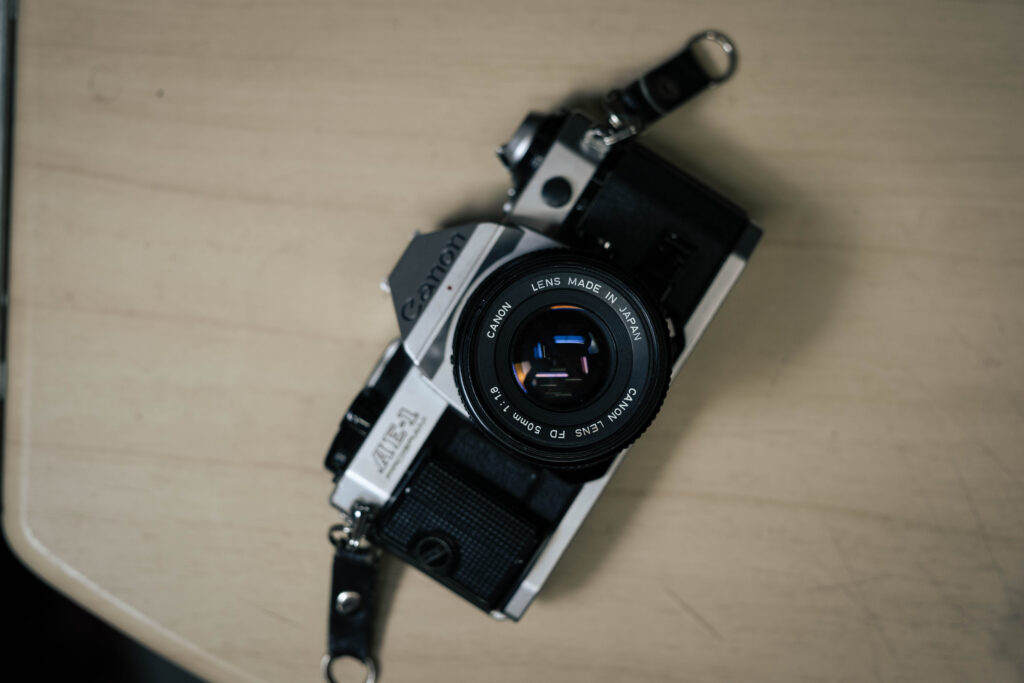
Nikon’s position in the Camera Industry
Let’s take a look at the big guy, Nikon. In the late 1970s and early 1980s, when Canon was collaborating with Texas Instruments, Nikon held a dominant position in the photography industry. Nikon was the preferred choice for professional photographers, with a strong reputation for quality and reliability. Innovation. Nikon had popularized many features in professional SLR photography, including modular camera systems, integrated light metering, and electronic shutter control.
While I have not been able to find exact figures, Nikon, along with Canon, held a significant portion of the SLR market. In the SLR/DSLR era, Canon and Nikon together had about 70% of the market share. Technological Transition. Nikon was in the process of transitioning from purely mechanical cameras to electronic ones. In 1980, they launched the Nikon F3, their first camera with an electronic shutter. They were definitely not the pioneer but they were not lagging that far back either.
Nikon was also active in the consumer camera market, releasing numerous models with advanced features like automatic exposure and integrated motor drives. But despite the innovations, Nikon maintained a conservative approach, prioritizing backwards compatibility with their F-mount lenses and catering to professionals who valued control and tradition… Man, I wish my Playstation 3 would have been backwards compatible.
Finally, as autofocus technology emerged in the mid 80’s, Nikon’s reliance on manual-focus systems began to appear outdated, presenting a challenge to their market position. This period marked the beginning of a shift in the industry, with Nikon’s dominance being challenged by emerging technologies and competitors like Canon.
Canon, Strong but Evolving
Our protagonist, Canon. At the time of the collaboration with Texas Instruments in the late 70’s and early 80’s, Canon was in a strong but evolving position in the photography industry. Canon was actively challenging Nikon’s dominance in the professional photography market. While Nikon was still the preferred choice for professionals, Canon was making significant strides.
Innovation Leader. Canon was at the forefront of innovation, particularly in consumer cameras. They were experimenting with automatic exposure, advanced metering, integrated motor drives, and eventually autofocus technology. Canon’s market share was increasing, especially in the consumer segment. The introduction of the Canonet (Rangefinders for budget enthusiasts) in 1961 had already helped solidify Canon’s position as a major player in the camera industry.
The 80’s marked a significant transition for Canon as they embraced electronic technology. The introduction of the T series in 1983 incorporated electronic control systems for aperture, shutter speed, and focus. Canon was actively working on autofocus technology, which would become a key differentiator in the coming years. Later, in 85, they released the T80, their first autofocus SLR camera.
Canon was positioning itself to capitalize on the emerging autofocus and electronic control trends in photography. Everything evolves and they made a good bet. This strategy would eventually lead to their EOS system, launched in 1987, which was designed specifically around autofocus technology. Canon was also expanding into other imaging markets, entering the video camcorder business at full scale in the early 80’s.
This period represented a crucial time for Canon, as they were laying the groundwork for their future dominance in the digital age of photography. At the time of writing this article, the same is happening but this time with AI. But that is a story for a different time. Let’s move to the other player on this collaboration.
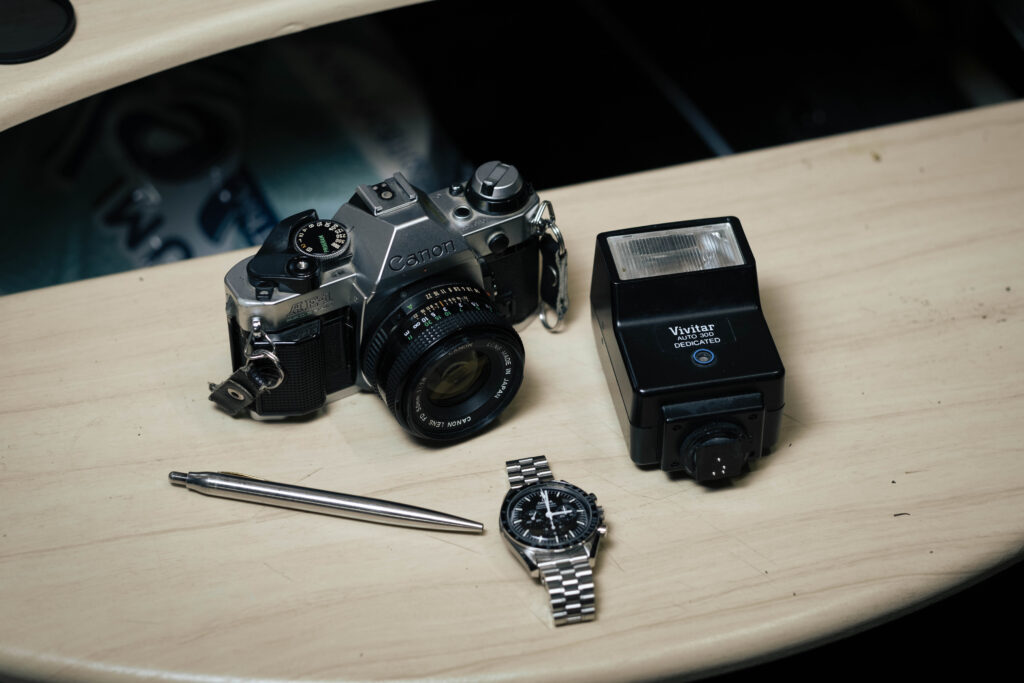
Enter Texas Instruments
Texas Instruments (TI) played a huge role developing the components for the AE-1 Program. Even though it was not TI specialty, they came through. At the time of the collaboration with Canon for the AE-1 Program in the late 70’s and early 80’s, TI was a dominant force in the electronics industry, but not specifically in microprocessors.
TI was the world’s leading producer of semiconductors, calculators, and digital watches. By 1980, TI’s annual sales had quintupled to $4 billion. Mind blowing. TI was seen as an innovative, aggressive company that was capable of competing with Japanese firms in consumer electronics. TI had a strong presence in various electronic sectors, including defense electronics, consumer products, and industrial applications.
Despite its overall strength, TI was not dominating the microprocessor industry specifically. In fact, TI had missed opportunities in this area: TI concentrated on four-bit microprocessors and initially ignored the rapidly developing market for eight-bit microprocessors. Intel, not TI, commercialized the 8008 microprocessor in 1972, which led to the development of the x86 architecture.
On the other hand, TI was a pioneer in memory chip technology, producing Dynamic Random Access Memory (DRAM) chips in 1974, which contributed significantly to their semiconductor sales. By the early 80’s, TI’s dominance in the semiconductor industry was being challenged, particularly by Japanese companies. Japan surpassed the US in global market share for memory chips in 1982.
Yes, TI was a major player in the electronics industry and a leader in semiconductor production during this period. But they were not dominating the microprocessor industry specifically. Their strengths lay in other areas of semiconductor technology and consumer electronics.
What Triggered the Collaboration Between TI and Canon?
The collaboration between Canon and Texas Instruments to create the AE-1 Program marked a significant turning point in the world of photography, revolutionizing camera design and manufacturing processes. This partnership was triggered by several factors and had far-reaching consequences:
Triggering Factors
Canon aimed to enter the mass market with an affordable yet high-performance SLR camera. One that could compete with compact cameras while appealing to enthusiasts. The rapid progress in electronics during the 70’s and 80’s presented an opportunity to innovate in camera design. Again, great vision and positioning by Canon here.
Canon needed to make their cameras more affordable to compete in the intense Japanese SLR market of the 70’s and 80’s. The use of microprocessors allowed Canon to eliminate about 300 parts (20-25%) compared to previous models, resulting in a more modular and easier-to-assemble design.
By-Product
The collaboration led to the first use of a microprocessor in an SLR camera. Not the AE-1 Program but the AE-1. This collaboration took advantage of Canon’s work with Texas Instruments on calculator microprocessors.
The results from the innovation that started on the AE-1 and carried over to the AE-1 Program were many. We can start with the innovative design and manufacturing processes. These changes made high-quality SLR cameras more accessible to amateur photographers. The inclusion of Program mode and other automated features made advanced photography techniques more accessible to beginners also.
As a result, the AE-1 Program helped Canon break Nikon’s dominance in the professional SLR market and appeal to a broader consumer base. The camera’s affordability and user-friendly features attracted millions of new amateur photographers to SLR photography.
The modular design enabled by microprocessors allowed for more automated assembly lines, reducing labor costs and increasing consistency. The use of plastics, disguised with anodized paint, allowed for lighter and cheaper cameras without compromising perceived quality.
The Canon-Texas Instruments collaboration for the AE-1 Program not only changed the landscape of photography in the 1980s but also set the stage for the digital revolution in imaging technology that would follow in subsequent decades.
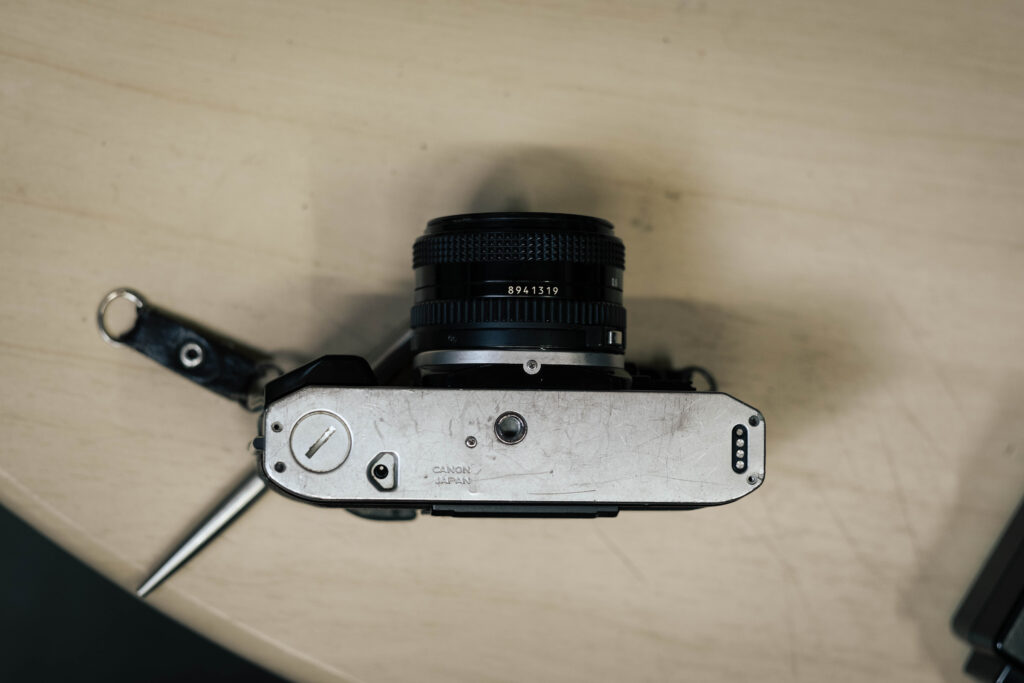
Challenges
Canon faced several significant challenges in integrating microprocessors into the AE-1 Program, building upon their experience with the original AE-1. These challenges were primarily related to technological limitations, design considerations, and manufacturing processes.
Processing Power
You may or may not be aware. But with new technology, like phones, more processing power is usually desired. The AE-1 Program as not exception. It required more advanced microprocessor technology compared to its predecessor. The Program mode and additional features demanded a more powerful microcomputer, with processing power two to three times that of the AE-1. Let’s consider that all incoming data had to be changed into pulse-controlled digital form to accommodate the increased functionality. Meaning, transforming mechanical inputs to digital.
Circuit Design
Integrating the microprocessor into the camera’s circuitry presented several challenges. Space constraints. Canon needed to fit more advanced electronics into a camera body that wasn’t significantly larger than the AE-1. Integration of components. The AE-1 Program used five integrated circuits (ICs), including a Pure L chip equivalent to over 300 pieces of regular IC. Specialized ICs. Canon had to develop custom ICs, such as one sealed into a single package with the SPC for the BI-MOS logarithmic amplifier.
Signal Processing and Accuracy
Ensuring accurate input and processing of data was crucial. Chatter elimination. Canon had to prevent signal chatter during aperture control, which could lead to mistaken counts of ON/OFF signal pulses. Precision components. A 23μ thick copper foil plated board with a tetron/epoxy coating was used to ensure smoothness within 5μ, preventing chatter in the aperture value detection. Gray code implementation. To ensure exact inputs for shutter speed, lens speed, and film speed, a Gray code was installed.
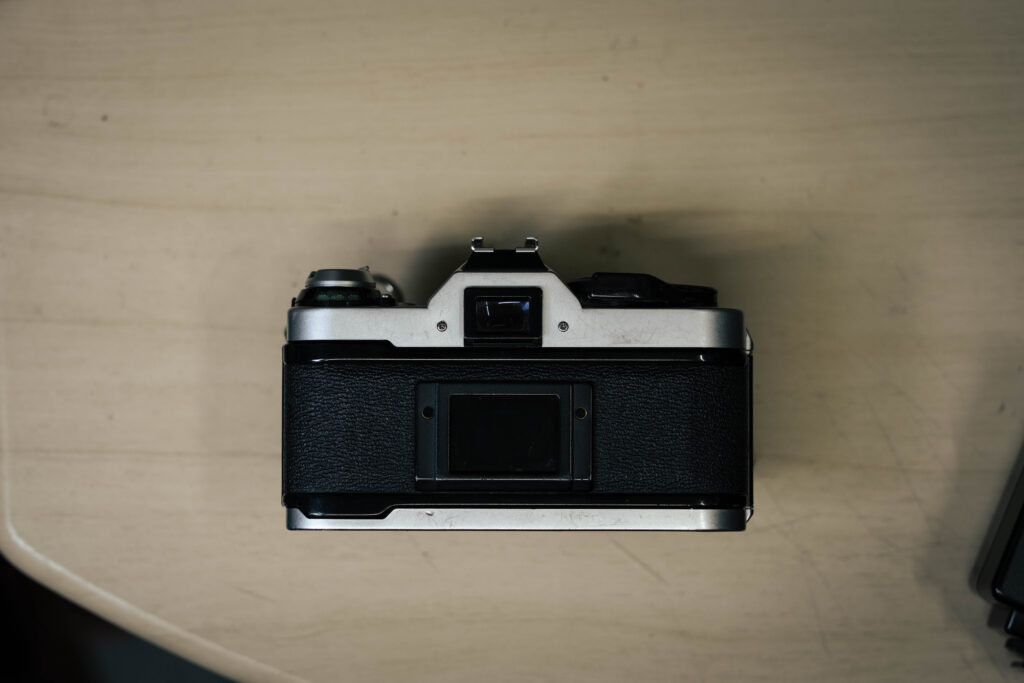
Manufacturing and Assembly
The integration of microprocessors required new manufacturing techniques, like automated production. The modular design enabled by microprocessors allowed for more automated assembly lines, which required new processes and equipment. Chip-on-board technique. Canon pioneered the use of chip-on-board for diode arrays, directly bonding six common four-cathode diode chips onto the circuit board to save space. Quality control. New inspection processes had to be developed to ensure the reliability of the electronic components and their integration with mechanical parts.
By overcoming these challenges, Canon was able to create a camera that was more advanced, yet still affordable and compact. The AE-1 Program’s success demonstrated Canon’s ability to innovate in both electronic and mechanical engineering, setting new standards for the camera industry.
The Canon AE-1 Program was revolutionizing for the photography world. Was it threatening to Nikon and their dominance? not really. It did challenge Nikon but did not hurt them. We can definitely conclude that the AE-1 Program was disruptive. Still one of the most used film cameras by enthusiast to this day. Myself included.
I hope this post was informative and entertaining for you. Thank you for stopping by.
DL
Discover more from 3DLANES
Subscribe to get the latest posts sent to your email.
